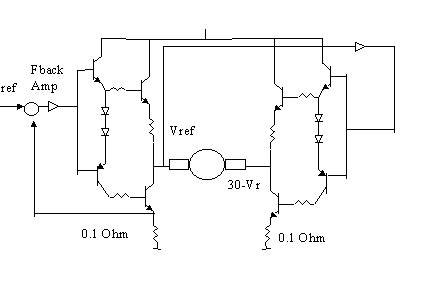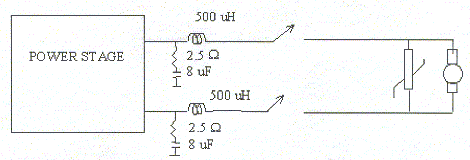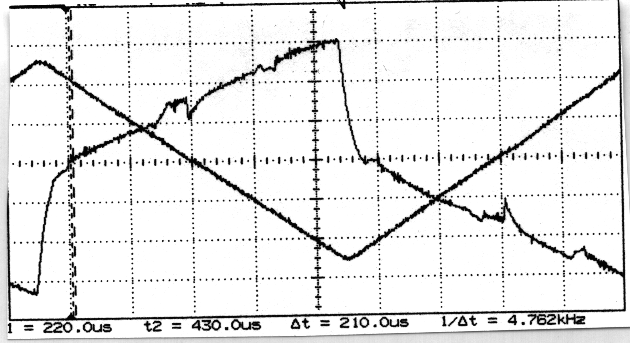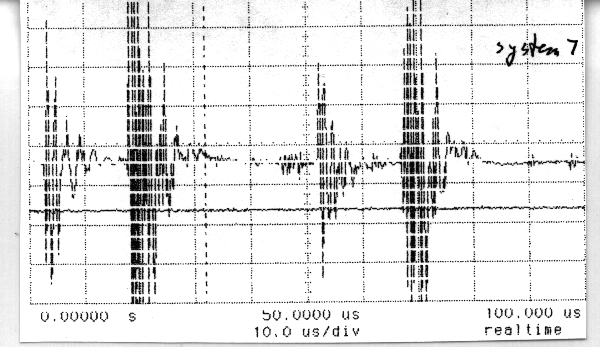
INTRODUCTION
This note discusses the problems and solutions found during the installation of the Glentek amplifiers used in driving the motors controlling altitude, azimuth and the instrument rotator for the 2.5 meter telescope.
The amplifier is an H-Bridge push-pull complementary pair, single voltage supply linear amplifier. It can source +/- 5 amps continuous and +/-18 amps peak with a 60 VDC source. The amplifier is made up of two sections: the input reference signal and tachometer signal conditioning section; and the power section.
Per the specifications received for packaging the amplifiers,
the signal conditioning section was bypassed and an external section with
signal driving capabilities was substituted. The output of the new signal
conditioning circuitry provides the input reference signal to the power
stage in the Glentek amplifier with a 1V = 10 A scale.
POWER SECTION
Operation of the H-Bridge consists of a complementary transistor pair turning on in a linear manner while a second pair is simultaneously turning off. The voltage balance at both outputs is 30 VDC when Vref is at zero volts, producing a net voltage drop across the motor of zero volts. As Vref increases, the base drive for one NPN-PNP pair increases while the base drive for second set of NPN-PNP transistors decreases. The voltage at one motor lead increases from 30 VDC towards 60 VDC while the voltage at the second motor lead decreases from 30 VDC towards 0 VDC.
The amplifier operates in a current mode through current sensing resistors and a feedback loop. The external voltage reference is compared with the current feedback, and this difference is amplified and used for driving the complementary transistor pair.

CONSTANT CURRENT MODE AMPLIFIER
Design system performance can be achieved by controlling system stability, speed of response, and position accuracy. The constant current amplifier impacts the speed of response by affecting the delay between the reference voltage and desired motor speed.
A DC motor voltage is represented by the motor electrical parameters, along with its constant and back EMF:
![]()
where ![]() and
and ![]() is
the back EMF constant
is
the back EMF constant
The generated motor torque is
![]() ,
,
where Kt is the motor torque sensitivity constant and the motor moment of inertia is related to the applied torque by
![]()
The current of the amplifier is related to the reference voltage as
![]() ,
,
where Ka is the amplifier constant.
As the impedance changes, the amplifier maintains a constant current, thereby eliminating the first equation and reducing the relationship between the current and omega to:
![]() ,
,
where S is the Laplacian operator
![]()
The integrating term S introduces a delay betweeen the reference voltage and the velocity by producing a constant -90 degree phase shift. The errors in position in the current regulated amplifier develop proportional to acceleration, and are reduced when the velocity is constant.
AMPLIFIER OSCILLATIONS AND THEIR SOURCES
The Glentek amplifier was characterized in the lab using a 2-ohm, 15 mH load connected to the output of the amplifier by 75 feet of 16 gauge wire. Across the load, MOVís were used to protect the output of the amplifiers due to the inductive kickback when the load-disconnect relays were opened. A sawtooth reference signal was used to drive the power stage in order to test negative-to-positive amplifier transitions.
Oscillations were measured on each of the amplifiersí outputs with respect to ground. These oscillations lead to amplifier failures over time due to increased power dissipation in the transistors. Measured oscillations fell into the following frequency ranges.
Medium Frequency 5 KHz to 70 KHz
Low Frequency
15 Hz to 360 Hz

The high frequencies measured are emitter-follower oscillations, and are the result of cable and load capacitance.

Oscillations were seen when the drive frequency was increased, as shown in Figure 3. At frequencies below 10 Hz, the transition from negative to positive region, the amplifier was stable. At frequencies above 10 Hz, the amplifier current loop could not keep up during the transition from the negative to positive region. This resulted in the voltage overdriving while trying to make up the current demand, thereby producing overshoots with high frequency oscillations. These measurements were done with a shunt RC snubber network connected at each of the amplifiersí output.



The first solution attempted to eliminate the oscillations was to connect a series inductance (500 uH) at the output of the amplifier. This attempted to isolate the cable and load impedance from the output stages and the current feedback loop. High frequency oscillations were eliminated in most amplifiers but not all of the amplifiers. An RC snubber network was added which eliminated the remaining high frequency emitter-follower oscillations. However, in some amplifiers this network caused the current loop to become unstable due to the addition of a circuit that provided a second reference to ground within the current loop. These medium frequency oscillations were dampened by increasing the capacitance value of the RC snubber to 2.5 ohm, 8 uF. This larger capacitance further reduced the amplifier gain at medium and high frequencies making it stable. The low frequencies were a result of line frequency type oscillations and were handled with line filtering. Figure 6 shows the addition of the inductors and RC snubber network on the output of the amplifier power stage.


AMPLIFIER INSTALLATION AND COMMISSIONING AT APO
Rotator Motor Drive
The seven packaged amplifiers were tested on the instrument rotator by driving the rotator clockwise and counterclockwise with a sawtooth signal. Initially, the RC snubber was not used, leaving the 500 uH series inductor between the amplifier output and the rotator motor leads. The rotator motor is a Model RHS 20-3007, rated at 1.9 amps, 4.8 amps peak, with a harmonic gear reduction drive connected to the shaft.
At the amplifier output, 120 Hz ripple was measured with 100 mV p-p amplitude; the high and medium frequencies were absent. While driving the amplifier with a sawtooth signal, oscillations of frequencies close to 850 Hz were detected. The amplitude was greatest at the motor output, indicating the source is from the motor harmonic reducer.
When the snubber RC circuit was added to one of the amplifiers, a 25 kHz oscillation of 200 mV p-p amplitude was measured. This oscillation was eliminated when the snubber RC was removed. Two packaged amplifiers were then dedicated to drive the rotator. The amplifier packages contain the 500 uH series inductor on each of the output leads of the amplifier, but do not contain the RC snubber network.

The five remaining packaged amplifiers were tested by driving the two altitude motors simultaneously. The altitude motors are Model No. QT 7802, permanent magnet brushed DC drive motors, with a nominal DC resistance of 2.5 ohms and 6.2 mH inductance, rated at 15.6 amps peak. Each motor had an MOV across its leads.
Measurements showed that 2 MHz and 7 MHz frequency oscillations were present without the RC snubber networks on two of the five systems tested. The shunt RC snubber was added to all five systems and these oscillations were reduced to less than 20 mV p-p.
Other frequencies detected were in the 60 Hz to 360 Hz range. These
line type frequencies had amplitudes ranging from 100 mV p-p to 200 mV
p-p. Two amplifier packages were connected as altitude drivers. The remaining
three amplifiers were used to test the azimuth motors.
Azimuth Motor Drive Measurements
The azimuth motors are of the same type as those used on the altitude
axis. Testing of the remaining packaged amplifiers was carried out with
the series inductance and the RC snubber network installed in all the remaining
amplifiers. No high frequencies were detected at the outputs. The altitude
and the azimuth packaged amplifiers are interchangeable, requiring both
the series inductors and the RC snubber networks.
NOISE FROM THE WINDSCREEN SERVO SYSTEM
Also detected during the amplifier testing was noise being generated on the AC power line by the windscreen motor drives. There was a 25 kHz oscillation radiated by the windscreen motor drive through the power line, which will be filtered at the windscreen drive using line filters. This noise is shown in Figure 9.

COMMENTS
Ideally all seven packaged amplifiers should be the same. The rotator amplifiers donít have the RC snubber network installed. Therefore to use the spare rotator amplifier or the altitude/azimuth amplifiers interchangeably, users must be aware of the RC snubber network.
The amplifiers cannot be considered unconditionally stable since the behavior of the amplifiers when the telescope is fully configured is not known. More measurements are required to try and understand why the series inductance did not make the amplifiers stable. Also the relationship between the RC snubbers and the current loop should be pursued even though there is no access in the power section to the actual components.
Also, it is noted that the output of these amplifiers has no short circuit protection.
I recommend that new amplifiers be purchased that donít have the problems
seen with the Glentek amplifiers.
Last modified 02/23/99
boroski@fnal.gov